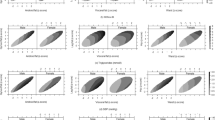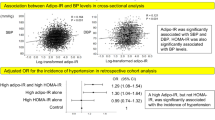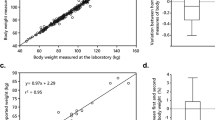Abstract
Objective:
Central fat mass (CFM) correlates with insulin resistance and increases the risk of type 2 diabetes and cardiovascular complications. On the other hand, increased peripheral fat mass (PFM) is associated with higher insulin sensitivity. Thus, we examined the contribution of adipose tissue distribution, as assessed by the PFM/CFM ratio, to insulin sensitivity in overweight and obese postmenopausal women.
Design and methods:
A total of 124 nondiabetic overweight and obese postmenopausal women underwent an oral glucose tolerance test (OGTT) and a hyperinsulinemic/euglycemic (HI) clamp. Body composition was determined using computed tomography for visceral adipose tissue (VAT) and dual X-ray absorptiometry for fat mass, lean body mass and their respective proportions. Participants were divided by tertiles of the PFM/CFM ratio.
Results:
Participants with preferential CFM (group 1) had higher fasting insulin levels and insulin area under the curve (AUC) during OGTT, as well as lower glucose infusion rates during the HI clamp, whether it was expressed per kg of body weight (M) or per kg of fat-free mass (Mm), compared with the other two groups. The PFM/CFM ratio also correlated significantly with fasting insulin (r=−0.32, P<0.001), the insulin AUC (r=−0.42 P<0.001), M (r=0.39 P<0.001) and Mm (r=0.37 P<0.001). Using hierarchical regression, we demonstrated that the PFM/CFM ratio was an independent predictor of insulin AUC, M and Mm and that its sequential addition to CFM and VAT improved significantly the predictive value of the model for insulin sensitivity for all variables except fasting insulin.
Conclusion:
The PFM/CFM ratio, which integrates the antagonistic effects of both central and peripheral depots on insulin sensitivity, added substantially to the prediction of insulin sensitivity over VAT and CFM alone.
This is a preview of subscription content, access via your institution
Access options
Subscribe to this journal
Receive 12 print issues and online access
$259.00 per year
only $21.58 per issue
Buy this article
- Purchase on Springer Link
- Instant access to full article PDF
Prices may be subject to local taxes which are calculated during checkout

Similar content being viewed by others
References
Despres JP, Lemieux I . Abdominal obesity and metabolic syndrome. Nature 2006; 444: 881–887.
Ferrannini E, Natali A, Bell P, Cavallo-Perin P, Lalic N, Mingrone G . Insulin resistance and hypersecretion in obesity. European Group for the Study of Insulin Resistance (EGIR). J Clin Invest 1997; 100: 1166–1173.
Karelis AD, Brochu M, Rabasa-Lhoret R, Garrel D, Poehlman ET . Clinical markers for the identification of metabolically healthy but obese individuals. Diabetes Obes Metab 2004; 6: 456–457.
Conus F, Rabasa-Lhoret R, Peronnet F . Characteristics of metabolically obese normal-weight (MONW) subjects. Appl Physiol Nutr Metab 2007; 32: 4–12.
Bonora E, Kiechl S, Willeit J, Oberhollenzer F, Egger G, Targher G et al. Prevalence of insulin resistance in metabolic disorders: the Bruneck Study. Diabetes 1998; 47: 1643–1649.
Karelis AD, Faraj M, Bastard JP, St-Pierre DH, Brochu M, Prud'homme D et al. The metabolically healthy but obese individual presents a favorable inflammation profile. J Clin Endocrinol Metab 2005; 90: 4145–4150.
Chan JM, Rimm EB, Colditz GA, Stampfer MJ, Willett WC . Obesity, fat distribution, and weight gain as risk factors for clinical diabetes in men. Diabetes Care 1994; 17: 961–969.
Kissebah AH, Peiris AN . Biology of regional body fat distribution: relationship to non-insulin-dependent diabetes mellitus. Diabetes Metab Rev 1989; 5: 83–109.
Despres JP . Is visceral obesity the cause of the metabolic syndrome? Ann Med 2006; 38: 52–63.
Folsom AR, Stevens J, Schreiner PJ, McGovern PG . Body mass index, waist/hip ratio, and coronary heart disease incidence in African Americans and whites. Atherosclerosis Risk in Communities Study Investigators. Am J Epidemiol 1998; 148: 1187–1194.
Megnien JL, Denarie N, Cocaul M, Simon A, Levenson J . Predictive value of waist-to-hip ratio on cardiovascular risk events. Int J Obes Relat Metab Disord 1999; 23: 90–97.
Yusuf S, Hawken S, Ounpuu S, Bautista L, Franzosi MG, Commerford P et al. Obesity and the risk of myocardial infarction in 27,000 participants from 52 countries: a case–control study. Lancet 2005; 366: 1640–1649.
Snijder MB, Visser M, Dekker JM, Goodpaster BH, Harris TB, Kritchevsky SB et al. Low subcutaneous thigh fat is a risk factor for unfavourable glucose and lipid levels, independently of high abdominal fat. The Health ABC Study. Diabetologia 2005; 48: 301–308.
Paradisi G, Smith L, Burtner C, Leaming R, Garvey WT, Hook G et al. Dual energy X-ray absorptiometry assessment of fat mass distribution and its association with the insulin resistance syndrome. Diabetes Care 1999; 22: 1310–1317.
Gan SK, Kriketos AD, Poynten AM, Furler SM, Thompson CH, Kraegen EW et al. Insulin action, regional fat, and myocyte lipid: altered relationships with increased adiposity. Obes Res 2003; 11: 1295–1305.
Lau DC, Douketis JD, Morrison KM, Hramiak IM, Sharma AM, Ur E, Obesity Canada Clinical Practice Guidelines Expert Panel. 2006 Canadian clinical practice guidelines on the management and prevention of obesity in adults and children [summary]. CMAJ 2007; 176: S1–S13.
Balkau B, Deanfield JE, Després JP, Bassand JP, Fox KA, Smith Jr SC et al. International Day for the Evaluation of Abdominal Obesity (IDEA): a study of waist circumference, cardiovascular disease, and diabetes mellitus in 168,000 primary care patients in 63 countries. Circulation 2007; 116: 1942–1951.
Bastard JP, Vandernotte JM, Faraj M, Karelis AD, Messier L, Malita FM et al. Relationship between the hyperinsulinemic-euglycaemic clamp and a new simple index assessing insulin sensitivity in overweight and obese postmenopausal women. Diabetes Metab 2007; 33: 261–268.
Karelis AD, Tousignant B, Nantel J, Proteau-Labelle M, Malita FM, St-Pierre DH et al. Association of insulin sensitivity and muscle strength in overweight and obese sedentary postmenopausal women. Appl Physiol Nutr Metab 2007; 32: 297–301.
American Diabetes Association. Screening for Diabetes. Diabetes Care 2002; 25: 21S–24S.
DeFronzo RA, Tobin JD, Andres R . Glucose clamp technique: a method for quantifying insulin secretion and resistance. Am J Physiol 1979; 237: E214–E223.
Smith Jr SC . Multiple risk factors for cardiovascular disease and diabetes mellitus. Am J Med 2007; 120 (3 Suppl 1): S3–S11.
Sowers JR . Obesity as a cardiovascular risk factor. Am J Med 2003; 115 (Suppl 8A): 37S–41S.
McFarlane SI, Banerji M, Sowers JR . Insulin resistance and cardiovascular disease. J Clin Endocrinol Metab 2001; 86: 713–718.
Lissner L, Björkelund C, Heitmann BL, Seidell JC, Bengtsson C . Larger hip circumference independently predicts health and longevity in a Swedish female cohort. Obes Res 2001; 9: 644–646.
Tanko LB, Bagger YZ, Alexandersen P, Larsen PJ, Christiansen C . Central and peripheral fat mass have contrasting effect on the progression of aortic calcification in postmenopausal women. Eur Heart J 2003; 24: 1531–1537.
Snijder MB, Dekker JM, Visser M, Bouter LM, Stehouwer CD, Yudkin JS et al. Hoorn study. Trunk fat and leg fat have independent and opposite associations with fasting and postload glucose levels: the Hoorn study. Diabetes Care 2004; 27: 372–377.
Ferreira I, Snijder MB, Twisk JW, van Mechelen W, Kemper HC, Seidell JC et al. Central fat mass versus peripheral fat and lean mass: opposite (adverse versus favorable) associations with arterial stiffness? The Amsterdam Growth and Health Longitudinal Study. J Clin Endocrinol Metab 2004; 89: 2632–2639.
Van Pelt RE, Evans EM, Schechtman KB, Ehsani AA, Kohrt WM . Contributions of total and regional fat mass to risk for cardiovascular disease in older women. Am J Physiol Endocrinol Metab 2002; 282: E1023–E1028.
Wajchenberg BL . Subcutaneous and visceral adipose tissue: their relation to the metabolic syndrome. Endocr Rev 2000; 21: 697–738.
Abdul-Ghani MA, Matsuda M, Balas B, DeFronzo RA . Muscle and liver insulin resistance indexes derived from the oral glucose tolerance test. Diabetes Care 2007; 30: 89–94.
Mulligan K, Grunfeld C, Tai VW, Algren H, Pang M, Chernoff DN et al. Hyperlipidemia and insulin resistance are induced by protease inhibitors independent of changes in body composition in patients with HIV infection. J Acquir Immune Defic Syndr 2000; 23: 35–43.
Kahn SE, Haffner SM, Heise MA, Herman WH, Holman RR, Jones NP et al. ADOPT Study Group. Glycemic durability of rosiglitazone, metformin, or glyburide monotherapy. N Engl J Med 2006; 355: 2427–2443.
Yang X, Smith U . Adipose tissue distribution and risk of metabolic disease: does thiazolidinedione-induced adipose tissue redistribution provide a clue to the answer? Diabetologia 2007; 50: 1127–1139.
Akazawa S, Sun F, Ito M, Kawasaki E, Eguchi K . Efficacy of troglitazone on body fat distribution in type 2 diabetes. Diabetes Care 2000; 23: 1067–1071.
Kawai T, Takei I, Oguma Y, Ohashi N, Tokui M, Oguchi S et al. Effects of troglitazone on fat distribution in the treatment of male type 2 diabetes. Metabolism 1999; 48: 1102–1107.
Smith SR, De Jonge L, Volaufova J, Li Y, Xie H, Bray GA . Effect of pioglitazone on body composition and energy expenditure: a randomized controlled trial. Metabolism 2005; 54: 24–32.
Paniagua J, Gallego de la Sacristana A, Romero I, Vidal-Puig A, Latre JM, Sanchez E et al. MUFA-rich diet prevents central body fat distribution and decreases postprandial adiponectin expression induced by a carbohydrate-rich diet in insulin-resistant subjects. Diabetes Care 2007; 30: 1717–1723.
Smith U . Regional differences in adipocyte metabolism and possible consequences in vivo. Int J Obes 1985; 9 (Suppl 1): 145–148.
Rebuffe-Scrive M, Enk L, Crona N, Lönnroth P, Abrahamsson L, Smith U et al. Fat cell metabolism in different regions in women. Effect of menstrual cycle, pregnancy, and lactation. J Clin Invest 1985; 75: 1973–1976.
Prentki M, Nolan CJ . Islet {beta} cell failure in type 2 diabetes. J Clin Invest 2006; 116: 1802–1812.
Havel PJ . Update on adipocyte hormones: regulation of energy balance and carbohydrate/lipid metabolism. Diabetes 2004; 53 (Suppl 1): S143–S151.
Lihn AS, Bruun JM, He G, Pedersen SB, Jensen PF, Richelsen B . Lower expression of adiponectin mRNA in visceral adipose tissue in lean and obese subjects. Mol Cell Endocrinol 2004; 219: 9–15.
Kelley DE . Skeletal muscle triglycerides: an aspect of regional adiposity and insulin resistance. Ann NY Acad Sci 2002; 967: 135–145.
Acknowledgements
Rémi Rabasa-Lhoret holds Fonds de la recherche en santé du Québec (FRSQ) research scholar grants. May Faraj is a recipient of the Canadian Institutes of Health Research (CIHR) New Investigator Award. This study was supported by grants from the CIHR New Emerging Teams in Obesity (Université de Montréal and University of Ottawa; the MONET project) and a CIHR Operating Grant. We thank Lyne Messier for coordinating this study, Miguel Chagnon for his precious advice on statistical analyses and Stéphanie Chevalier for critical reading of the manuscript. The editorial assistance of Mr Ovid Da Silva, Research Support Office, Research Centre, Centre hospitalier de l'Université de Montréal (CHUM), is acknowledged.
Author information
Authors and Affiliations
Corresponding author
Rights and permissions
About this article
Cite this article
Tousignant, B., Faraj, M., Conus, F. et al. Body fat distribution modulates insulin sensitivity in post-menopausal overweight and obese women: a MONET study. Int J Obes 32, 1626–1632 (2008). https://doi.org/10.1038/ijo.2008.163
Received:
Revised:
Accepted:
Published:
Issue Date:
DOI: https://doi.org/10.1038/ijo.2008.163
Keywords
This article is cited by
-
Differences in the metabolic status of healthy adults with and without active brown adipose tissue
Wiener klinische Wochenschrift (2013)



